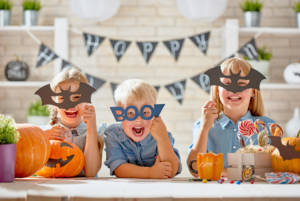The Christian and Pagan Roots of Halloween
Halloween is a billion-dollar industry in Canada, ranking only second behind Christmas among profitable holidays. As with many modern holidays, it appears to be a mingling of Christian religious observances and Celtic pre-Christian traditions originating in an older festival known as Samhain. So where does Samhain end and Halloween begin? Keep a dish of sweet treats nearby to nosh on as you read through the mysteries behind this popular spooky celebration.
Is Halloween a Celtic Import?
The Canadian Encyclopedia reveals that Halloween’s most popular traditions came to North America sometime in the 1800s. The first documented instance in Canada of costume wearing occurred in Vancouver in 1898, while “trick or treat” was first recorded in Alberta in 1927. The Canadian Encyclopedia’s entry further suggests that these customs likely migrated here with Irish and Scottish immigrants. South of the border, the United States Library of Congress’ American Folklife Center appears to back up the assertion that Halloween came to us from Celtic Europe, with its observance rooted in older Samhain practices.
Samhain: A Time for Harvests and Spirits
The modern Irish term “Samhain” (pronounced “SOW-in”) refers to end-of-harvest revelries. It’s hard to ascertain when ancient Celts began marking the end of autumn, but the oldest documented example appears in Irish literature from around the 10th century C.E. Prior to that, Irish mythology mostly existed as spoken word traditions. Samhain’s festivities were held starting at sundown on October 31 and ending at dusk on November 1, a date that originally lined up with the Celts’ New Year. It’s also one of the four major seasonal holidays, along with Imbolc, Beltaine and Lughnasadh, on the ancient Celtic calendar.
Besides heralding the arrival of the cold season, these pre-Christian Celtic peoples believed that the barrier between the land of the living and the realm of the dead thinned at Samhain, allowing the souls of the dead to enter the waking world. Bonfires were lit to honor them and encourage their return to the Otherworld, a vast supernatural plane in which fairies, demons, deities and departed souls dwelled. Because these beings were thought to wander around on Samhain, offerings of food and drink were left out so that they’d leave the living alone.
Christianity and All Hallows’ Eve
Multiple sources have pointed to Catholicism’s adoption of pagan holidays into its own liturgical calendar. For instance, the December 25 date of Christmas also coincides with older celebrations of Saturnalia in ancient Rome and mid-winter celebrations across the rest of Europe. The American Folklore Center remarks that Pope Gregory I actively sought to absorb older customs and celebrations from non-Christian cultures in hopes of converting more people.
As Church leaders demonized native Celtic beliefs and condemned their Druids as devil worshippers, the All Saints feast was also moved to November 1. The day before became known as All Hallows’ Eve, yet the association of October 31 and November 1 with the mythology of Samhain never completely faded. Older Celtic practices of playing pranks, wearing disguises to confuse the dead and leaving out treats to mollify malicious spirits continued.
Modern-Day Celebrations in Canada
While some fundamentalist Christians condemn Halloween as evil, the Canadian Encyclopedia disclosed that 68 percent of Canadians participate in its festivities every year. Followers of Celtic Neopagan spiritual paths might mark the day with bonfires, magical and ritualistic celebrations, and gatherings with friends and family. Moreover, the people who buy candies, dress up for trick or treat and throw Halloween parties come from many different faiths. With pagan and Christian contributions to the modern holiday and the childlike wonder and fun it can bring, there’s little surprise as to why it remains popular with Canadians in the 21st century.


